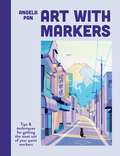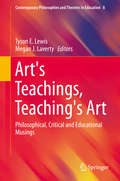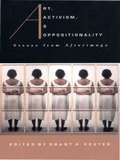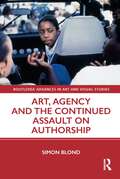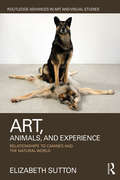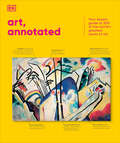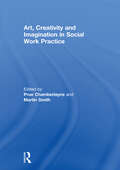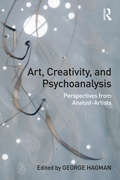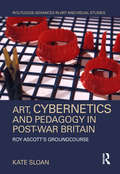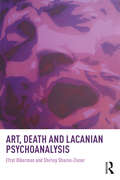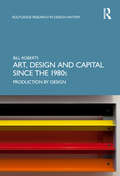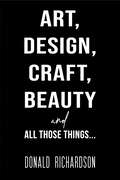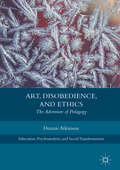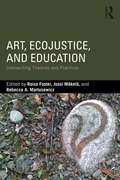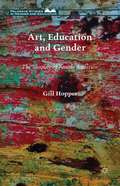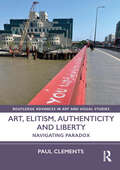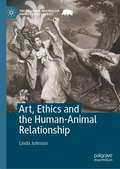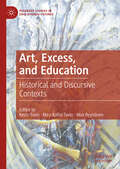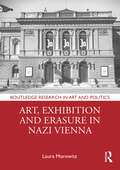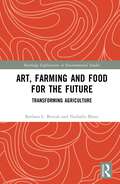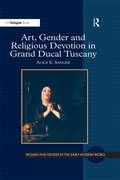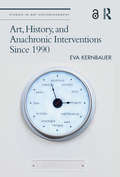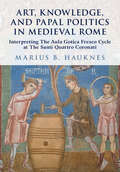- Table View
- List View
Art with Markers: Tips & techniques for getting the most out of your paint markers
by Angela PanVersatile and accessible, acrylic paint markers are the must-have art material for beginner and experienced artists alike. Under the expert guidance of artist and educator Angela Pan, learn how to get to grips with your acrylic marker set and really master the medium.Begin with an introduction to using your markers, with tips on materials, choosing colours and mixing, including specific tips for Posca and Molotow acrylic markers. Next, learn how to draw different kinds of flowers and trees. Once you have these under your belt, move on to 22 step-by-step projects that show you how to create stunning landscapes and city scenes using your acrylic markers.Projects include:· Snow-covered mountain· Sunrise in Tuscany· Blue hour in Lisbon· Sunset in the Dolomites· Japanese Diner· Zurich at Twilight
Art's Teachings, Teaching's Art: Philosophical, Critical and Educational Musings (Contemporary Philosophies and Theories in Education #8)
by Tyson Lewis Megan LavertyThis volume examines the interface between the teachings of art and the art of teaching, and asserts the centrality of aesthetics for rethinking education. Many of the essays in this collection claim a direct connection between critical thinking, democratic dissensus, and anti-racist pedagogy with aesthetic experiences. They argue that aesthetics should be reconceptualized less as mere art appreciation or the cultivation of aesthetic judgment of taste, and more with the affective disruptions, phenomenological experiences, and the democratic politics of learning, thinking, and teaching. The first set of essays in the volume examines the unique pedagogies of the various arts including literature, poetry, film, and music. The second set addresses questions concerning the art of pedagogy and the relationship between aesthetic experience and teaching and learning. Demonstrating the flexibility and diversity of aesthetic expressions and experiences in education, the book deals with issues such as the connections between racism and affect, curatorship and teaching, aesthetic experience and the common, and studying and poetics. The book explores these topics through a variety of theoretical and philosophical lenses including contemporary post-structuralism, psychoanalysis, phenomenology, critical theory, and pragmatism.
Art, Activism, and Oppositionality: Essays from Afterimage
by Grant H. KesterThere is a common perception in the arts today that overtly activist artæoften seen to sacrifice an aesthetic pleasure for a subversive oneæis no longer in fashion. In bringing together sixteen of the most important essays on activist and community-based art from the pages of Afterimageæone of the most influential journals in the media and visual arts fields for more than twenty-five yearsæGrant H. Kester demonstrates that activist art, far from being antithetical to the true meaning of the aesthetic, can be its most legitimate expression.Forging a style of criticism where aesthetic, critical, theoretical, and activist concerns converge, Afterimage has shaped American debates around the politics of visual production and arts education while offering a voice to politically involved artists and scholars. Art, Activism, and Oppositionality insists not only on the continuing relevance of an activist stance to contemporary art practice and criticism, but also on the significance of an engaged art practice that is aligned with social or political activism. With essays that span fifteen yearsæroughly from Ronald Reagan's 1980 presidential win to the 1994 Republican victories in Congress, a period marked by waning public support for the arts and growing antagonism toward activist art æArt, Activism, and Oppositionality confronts issues ranging from arts patronage, pedagogy, and the very definitions of art and activism to struggles involving AIDS, reproductive rights, sexuality, and racial identity.Art, Activism, and Oppositionality will interest students and scholars of contemporary art history, media studies, cultural studies, and the fine arts, as well as, arts activists, critics, and arts administrators.Contributors. Maurice Berger, Richard Bolton, Ann Cvetkovich, Coco Fusco, Brian Goldfarb, Mable Haddock, Grant H. Kester, Ioannis Mookas, Chiquita Mullins Lee, Darrell Moore, Lorraine O'Grady, Michael Renov, Martha Rosler, Patricia Thomson, David Trend, Charles A. Wright Jr., Patricia R. Zimmerman
Art, Agency and the Continued Assault on Authorship (Routledge Advances in Art and Visual Studies)
by Simon BlondThis book presents a counter-history to the relentless critique of the humanist subject and authorial agency that has taken place over the past fifty years. It is both an interrogation of that critique and the tracing of an alternative narrative from Romanticism to the twenty-first century which celebrates the agency of the artist as a powerful contribution to the wellbeing of the community. It does so through arguments based on philosophical aesthetics and cultural theory interspersed with case histories of particular artists. It also engages with a second issue that cannot be separated from the first. This is the question of what the role and purpose of art is in society. This has become particularly important since the 1990s because of the "social turn" in art in which it is claimed that the only valid role for art was one that had explicit social consequences. This book argues that a political role for art is valuable, but not the only one that can be envisaged nor indeed is it the most obvious or most important. Art has other social roles both as a means to engender empathy and community, and to re-enchant a world bereft of meaning and reduced to material values. The book will appeal to practising artists as well as scholars working in art history, philosophy, aesthetics, and curatorial studies.
Art, Angst, and Trauma: Right Brain Interventions with Developmental Issues
by Doris Banowsky ArringtonArrington, a licensed clinical psychologist, brings together 15 essays on the use of art therapy with children who are seriously ill, in foster care, or physically and emotionally traumatized.
Art, Animals, and Experience: Relationships to Canines and the Natural World (Routledge Advances in Art and Visual Studies)
by Elizabeth SuttonElizabeth Sutton, using a phenomenological approach, investigates how animals in art invite viewers to contemplate human relationships to the natural world. Using Rembrandt van Rijn’s etching of The Presentation in the Temple (c. 1640), Joseph Beuys’s social sculpture I Like America and America Likes Me (1974), archaic rock paintings at Horseshoe Canyon, Canyonlands National Park, and examples from contemporary art, this book demonstrates how artists across time and cultures employed animals to draw attention to the sensory experience of the composition and reflect upon the shared sensory awareness of the world.
Art, Annotated: The World's 500 Greatest Paintings Explained
by DKA stunning art gallery in a book, art, annotated spans more than 3,000 years of paintings, sculptures, and prints.Combining reproductions of each work of art with precise annotations and visual analysis, it is an expertly curated selection of the finest art ever created.Immerse yourself in this book and learn all about art - how Michelangelo painted nudes, what cubism is, and where abstraction came from. Discover ancient Egyptian frescoes, read the visual clues to Leonardo da Vinci's Last Supper, and find out what inspired Louise Bourgeois and Banksy.In this art book, you will find:Art from all over the world exploring key elements such as composition, color, technique, and symbolism.Profiles the work of more than 450 artists from across the world and many different cultures, covering every period and major art movement.Art set in its historical context, which makes art, annotated a complete overview of art history.An optional 32-page directory of biographies of all the artists featured at the back of the book.Packed with information and full of inspiration, art, annotated brings the finest paintings and sculptures right into your home. It is the ultimate history of art and visual sourcebook for all art lovers.
Art, Anthropology and the Gift (Criminal Practice Ser.)
by Roger SansiIn recent decades, the dialogue between art and anthropology has been both intense and controversial. Art, Anthropology and the Gift provides a much-needed and comprehensive overview of this dialogue, whilst also exploring the reciprocal nature of the two subjects through practice, theory and politics. Fully engaging with anthropology and art theory, this book innovatively argues that art and anthropology don’t just share methodologies, but also deeper intellectual, theoretical and even political concerns, inviting scholars and students alike to look at this contentious relationship in a more critical light. One of the central arguments of the book is that the problem of the ‘gift’ has been central to both anthropological and artistic practice. This very idea connects the different chapters on topics including aesthetics, politics, participation and fieldwork.
Art, Creativity and Imagination in Social Work Practice.
by Prue Chamberlayne and Martin SmithHarnessing the inspiration available from the arts and the imagination brings to life sensitive and effective social work practice. Workers feel most satisfied while service users and communities are more likely to benefit when creative thinking can be applied to practice dilemmas. Drawing on contributions from Canada, England and Utrecht this book illustrates the transforming effect of creatively applied thinking to social problems. The first part of the book considers how use of the self can be enhanced by analytic reflection and application to difficulties facing individuals and communities. The second part shows psychodynamic theory to be a valuable aid when thinking about issues faced by social workers facing threats and accusations, therapeutic work with children and restorative youth justice. The third part of the book considers the implications of working with the arts in community settings – an ex-mining community in North West England, the Tate Gallery in London and the ‘cultural capital’ of Liverpool. Taken as a whole these chapters combine to inspire and provoke thought of how the arts and the imagination can be used creativity to help service users confronted by problems with living and the workers who attempt to get alongside them to think about these.This book was published as a special issue of the Journal of Social Work Practice.
Art, Creativity, and Psychoanalysis: Perspectives from Analyst-Artists
by George HagmanArt, Creativity, and Psychoanalysis: Perspectives from Analyst-Artists collects personal reflections by therapists who are also professional artists. It explores the relationship between art and analysis through accounts by practitioners who identify themselves as dual-profession artists and analysts. The book illustrates the numerous areas where analysis and art share common characteristics using first-hand, in-depth accounts. These vivid reports from the frontier of art and psychoanalysis shed light on the day-to-day struggle to succeed at both of these demanding professions. From the beginning of psychoanalysis, many have made comparisons between analysis and art. Recently there has been increasing interest in the relationship between artistic and psychotherapeutic practices. Most important, both professions are viewed as highly creative with spontaneity, improvisation and aesthetic experience seeming to be common to each. However, differences have also been recognized, especially regarding the differing goals of each profession: art leading to the creation of an art work, and psychoanalysis resulting in the increased welfare and happiness of the patient. These issues are addressed head-on in Art, Creativity, and Psychoanalysis: Perspectives from Analyst-Artists. The chapters consist of personal essays by analyst/artists who are currently working in both professions; each has been trained in and is currently practicing psychoanalysis or psychoanalytic psychotherapy. The goal of the book is to provide the audience with a new understanding of psychoanalytic and psychotherapeutic processes from the perspective of art and artistic creativity. Drawing on artistic material from painting, poetry, photography, music and literature, the book casts light on what the creative processes in art can add to the psychoanalytic endeavor, and vice versa. Art, Creativity, and Psychoanalysis: Perspectives from Analyst-Artists will appeal to psychoanalysts and psychoanalytic psychotherapists, theorists of art, academic artists, and anyone interested in the psychology of art.
Art, Cybernetics and Pedagogy in Post-War Britain: Roy Ascott’s Groundcourse (Routledge Advances in Art and Visual Studies)
by Kate SloanThis is the first full-length study about the British artist Roy Ascott, one of the first cybernetic artists, with a career spanning seven decades to date. The book focuses on his early career, exploring the evolution of his early interests in communication in the context of the rich overlaps between art, science and engineering in Britain during the 1950s and 1960s. The first part of the book looks at Ascott’s training and early work. The second park looks solely at Groundcourse, Ascott’s extraordinary pedagogical model for visual arts and cybernetics which used an integrative and systems-based model, drawing in behaviourism, analogue machines, performance and games. Using hitherto unpublished photographs and documents, this book will establish a more prominent place for cybernetics in post-war British art.
Art, Death and Lacanian Psychoanalysis
by Efrat Biberman Shirley Sharon-ZisserArt, Death and Lacanian Psychoanalysis examines the relationship between art and death from the perspective of Lacanian psychoanalysis. It takes a unique approach to the topic by making explicit reference to the death drive as manifest in theories of art and in artworks. Freud’s treatment of death focuses not on the moment of biological extinction but on the recurrent moments in life which he called "the death drive" or the "compulsion to repeat": the return precisely of what is most unbearable for the subject. Surprisingly, in some of its manifestations, this painful repetition turns out to be invigorating. It is this invigorating repetition that is the main concern of this book, which demonstrates the presence of its manifestations in painting and literature and in the theoretical discourse concerning them from the dawn of Western culture to the present. After unfolding the psychoanalytical and philosophical underpinnings for the return of the death drive as invigorating repetition in the sphere of the arts, the authors examine various aspects of this repetition through the works of Gerhard Richter, Jeff Wall, and contemporary Israeli artists Deganit Berest and Yitzhak Livneh, as well as through the writings of Virginia Woolf and James Joyce. First to articulate the stimulating aspect of the death drive in its relation to the arts and the conception of art as a varied repetition beyond a limit, Art, Death and Lacanian Psychoanalysis will be indispensable to psychoanalysts, scholars of art theory and aesthetics and those studying at the intersection of art and psychoanalysis.
Art, Design and Capital since the 1980s: Production by Design (Routledge Research in Design History)
by Bill RobertsThis book examines artists’ engagements with design and architecture since the 1980s, and asks what they reveal about contemporary capitalist production and social life. Setting recent practices in historical relief, and exploring the work of Dan Graham, Rita McBride, Tobias Rehberger and Liam Gillick, Bill Roberts argues that design is a singularly valuable lens through which artists evoke, trace and critique the forces and relations of production that underpin everyday experience in advanced capitalist economies.
Art, Design, Craft, Beauty and All Those Things…
by Donald RichardsonResponding to many recent calls for redress and restitution, Richardson summarises the historical and current situation and attributes its problematics to the fact that theorists and historians have taken the concept art as a generic that includes both design and craft – which are actually and validly distinguishable from art by application of the concept function/al – or else ignored the two entirely. Considering the concept function/al, he maintains, calls into question the view that the three may be sub-classes of the one class: whereas in a work of art, typically there is a resolution of the tension between form and content, in works of design and craft the resolution is between form and function. How this recognition can clarify the issue informs the entire book. The book’s other major thesis is the realisation that aesthetic values are inherently human and that, therefore, they apply not only to art but to life in general. Far from being frivolous or a mere ‘emotion’, the aesthetic is a sense of equivalent psychic status to sight and hearing and, like them, is employed at almost every moment of our daily lives – which fact grounds art, design and craft deeply in human life. This is reflected in the universal use of the human form (including the exhibition of sexual characteristics) in art. The eternal conflict between making art and making a living from making art is examined and contrasted to the rarely-recognised, but positive, role of design in planning and industry. Richardson also critiques common theories of representation and composition, including ‘creativity’, Albertian perspective and scientific and geometric theories of beauty and composition; also the relevance of the camera and the computer in the field.
Art, Disobedience, and Ethics: The Adventure of Pedagogy (Education, Psychoanalysis, and Social Transformation)
by Dennis AtkinsonThis book explores art practice and learning as processes that break new ground, through which new perceptions of self and world emerge. Examining art practice in educational settings where emphasis is placed upon a pragmatics of the 'suddenly possible', Atkinson looks at the issues of ethics, aesthetics, and politics of learning and teaching. These learning encounters drive students beyond the security of established patterns of learning into new and modified modes of thinking, feeling, seeing, and making.
Art, EcoJustice, and Education: Intersecting Theories and Practices
by Rebecca A. Martusewicz Raisa Foster Jussi MäkeläEmphasizing the importance of contemporary art forms in EcoJustice Education, this book examines the interconnections between social justice and ecological well-being, and the role of art to enact change in destructive systems. Artists, educators, and scholars in diverse disciplines from around the world explore the power of art to disrupt ways of thinking that are taken for granted and dominate modern discourses, including approaches to education. The EcoJustice framework presented in this book identifies three strands—cultural ecological analysis, revitalizing the commons, and enacting imagination—that help students to recognize the value in diverse ways of knowing and being, reflect on their own assumptions, and develop their critical analytic powers in relation to important problems. This distinctive collection offers educators a mix of practical resources and inspiration to expand their pedagogical practices. A Companion Website includes interactive artworks, supplemental resources, and guiding questions for students and instructors.
Art, Education and Gender: The Shaping Of Female Ambition (Palgrave Studies in Gender and Education)
by Gill HopperWhy do girls study art and why do girls become primary teachers? This book examines and reveals the powerful influence of the family, the school and the state in shaping female identity and constructing notions of gender appropriateness. It also discusses the status of art at school and the position of women artists in society.
Art, Elitism, Authenticity and Liberty: Navigating Paradox (Routledge Advances in Art and Visual Studies)
by Paul ClementsThis book excavates the depths of creative purpose and meaning-making and the extent to which artist autonomy and authenticity in art is a struggle against psychological conditioning, controlling cultural institutions and markets, key to which is representation.The chapters are underpinned by examples from the arts, and the narrative weaves a trail through a range of conceptualizations that are applied to various aspects of visual culture from mainstream canonical arts to avant-garde, community and public art; social and political art to commercial art; and ethereal art to the popular, edgy and kitsch. The book is wide-ranging and employs various aesthetic, cultural, philosophical, political, psycho-social and sociological debates to highlight the problems and contradictions that an encounter with the arts and creativity engenders.The book will be of interest to scholars working in art history, museum studies, arts management, cultural policy, cultural studies and cultural theory.
Art, Ethics and the Human-Animal Relationship (The Palgrave Macmillan Animal Ethics Series)
by Linda JohnsonThis book examines the works of major artists between the seventeenth and nineteenth centuries, as important barometers of individual and collective values toward non-human life. Once viewed as merely representational, these works can also be read as tangential or morally instrumental by way of formal analysis and critical theories. Chapter Two demonstrates the discrimination toward large and small felines in Genesis and The Book of Revelation. Chapter Three explores the cruel capture of free roaming animals and how artists depicted their furs, feathers and shells in costume as symbols of virtue and vice. Chapter Four identifies speciest beliefs between donkeys and horses. Chapter Five explores the altered Dutch kitchen spaces and disguised food animals in various culinary constructs in still life painting. Chapter Six explores the animal substances embedded in pigments. Chapter Seven examines animals in absentia-in the crafting of brushes. The book concludes with the fish paintings of William Merritt Chase whose glazing techniques demonstrate an artistic approach that honors fishes as sentient beings.
Art, Excess, and Education: Historical and Discursive Contexts (Palgrave Studies in Educational Futures)
by Kevin Tavin Mira Kallio-Tavin Max RyynänenThis book concentrates on the deep historical, political, and institutional relationships between art, education, and excess. Going beyond field specific discourses of art history, art criticism, philosophy, and aesthetics, it explores how the concept of excess has been important and enduring from antiquity through contemporary art, and from early film through the newer interactive media. Examples considered throughout the book focus on disgust, grandiosity, sex, violence, horror, disfigurement, endurance, shock, abundance, and emptiness, and frames them all within an educational context. Together they provide theories and classificatory systems, historical and political interpretations of art and excess, examples of popular culture, and suggestions for the future of educational practice.
Art, Exhibition and Erasure in Nazi Vienna (Routledge Research in Art and Politics)
by Laura MorowitzThis book examines three exhibitions of contemporary art held at the Vienna Künstlerhaus during the period of National Socialist rule and shows how each attempted to culturally erase elements anathema to Nazi ideology: the City, the Jewess and fin-de-siècle Vienna. Each of the exhibits was large scale and ambitious, part of a broader attempt to situate Vienna as the cultural capital of the Reich, and each aimed to reshape cultural memory and rewrite history. Applying illuminating theories on memory studies, collective and public memory, and notions of "memoricide," this is the first book in English to focus on visual culture in the period when Austria was erased as a nation and incorporated into the Third Reich as "Ostmark." The organization, content and publications surrounding these three exhibits are explored in depth and set against the larger political changes and dangerous ideologies they reflect. The book will be of interest to scholars working in art history, museum studies, cultural history, memory studies, art and politics and Holocaust studies.
Art, Farming and Food for the Future: Transforming Agriculture (Routledge Explorations in Environmental Studies)
by Nathalie Blanc Barbara L. BenishThis book explores the impact of artistic experiments in inspiring people to turn away from current food consumerism and take an active role in preserving, sustaining, and protecting the environment. As artists are expanding their practice into social justice and community concerns, erasing traditional forms of expression and integrating others, the culture around food and its production has been added to a new vocabulary of experiential art. The authors measure the impact of such experiments on local food consumption and production, focusing on education and youth, both in the surrounding community and culture at large. They suggest how these projects can be up-scaled to further encourage sustainable solutions for our environment and communities. The book explores the reflections and motivations of case study practitioners in urban and rural areas and, through interviews, engages with artists who are pioneering a new trend to create hubs of activity away from traditional art spaces in cities to follow a non-hierarchal practice that is de-centralized and communally based. This book will be of great interest to academic readers concerned with issues related to environmental aesthetics, eco-design, eco-criticism, culture, heritage, memory, and identity, and those interested in the current debates on the place of aesthetics and culture in sustainability.
Art, Gender and Religious Devotion in Grand Ducal Tuscany (Women and Gender in the Early Modern World)
by Alice E. SangerArt, Gender and Religious Devotion in Grand Ducal Tuscany focuses on the intersection of the visual and the sacred at the Medici court of the later sixteenth to early seventeenth centuries in relation to issues of gender. Through a series of case studies carefully chosen to highlight key roles and key interventions of Medici women, this book embraces the diversity of their activities, from their public appearances at the centre of processionals such as the bridal entrata, to the commissioning and collecting of art objects and the overseeing of architectural projects, to an array of other activities to which these women applied themselves with particular force and vigour: regular and special devotions, visits to churches and convents, pilgrimages and relic collecting. Positing Medici women’s patronage as a network of devotional, entrepreneurial and cultural activities that depended on seeing and being seen, Alice E. Sanger examines the specific religious context in which the Medici grand duchesses operated, arguing that these patrons’ cultural interests responded not only to aesthetic concerns and the demands of personal faith, but also to dynastic interests, issues of leadership and authority, and the needs of Catholic reform. By examining the religious dimensions of the grand duchesses' art patronage and collecting activities alongside their visually resonant devotional and public acts, Sanger adds a new dimension to the current scholarship on Medici women’s patronage.
Art, History, and Anachronic Interventions Since 1990 (Studies in Art Historiography)
by Eva KernbauerThis book examines contemporary artistic practices since 1990 that engage with, depict, and conceptualize history. Examining artworks by Kader Attia, Yael Bartana, Zarina Bhimji, Michael Blum, Matthew Buckingham, Tacita Dean, Harun Farocki and Andrei Ujica, Omer Fast, Andrea Geyer, Liam Gillick and Philippe Parreno, Hiwa K, Amar Kanwar, Bouchra Khalili, Deimantas Narkevičius, Wendelien van Oldenborgh, Walid Raad, Dierk Schmidt, Erika Tan, and Apichatpong Weerasethakul, Art, History, and Anachronic Interventions since 1990 undertakes a thorough methodological reexamination of the contribution of art to history writing and to its theoretical foundations. The analytical instrument of anachrony comes to the fore as an experimental method, as will (para)fiction, counterfactual history, testimonies, ghosts and spectres of the past, utopia, and the "juridification" of history. Eva Kernbauer argues that contemporary art—developing its own conceptual approaches to temporality and to historical research—offers fruitful strategies for creating historical consciousness and perspectives for political agency. The book will be of interest to scholars working in art history, historiography, and contemporary art.
Art, Knowledge, and Papal Politics in Medieval Rome: Interpreting the Aula Gotica Fresco Cycle at Santi Quattro Coronati
by Marius B. HauknesDiscovered in 1995, the remarkable thirteenth-century frescoes in the great hall, or Aula Gotica, of Rome's Santi Quattro Coronati complex are among the most important vestiges of medieval Italian painting. In this volume, Marius Hauknes offers a thorough investigation of the fresco cycle, which includes allegorical representations of the liberal arts, the virtues and vices, the seasons, the signs of the zodiac, and the months of the year. Hauknes relates these subjects to the papacy's growing interest in fields of worldly knowledge, such as music, time, astrology, and medicine. He argues that the Santi Quattro Coronati frescoes function as a large-scale, interactive encyclopedia that not only represented secular knowledge but also produced philosophical speculation, stimulating beholders to draw connections between pictorial motifs across architectural space. Integrating medieval intellectual history with close attention to multi-sensory and architectural conditions of fresco Hauknes' study offers new insights into religion, art, science, and spectatorship in medieval Italy.
